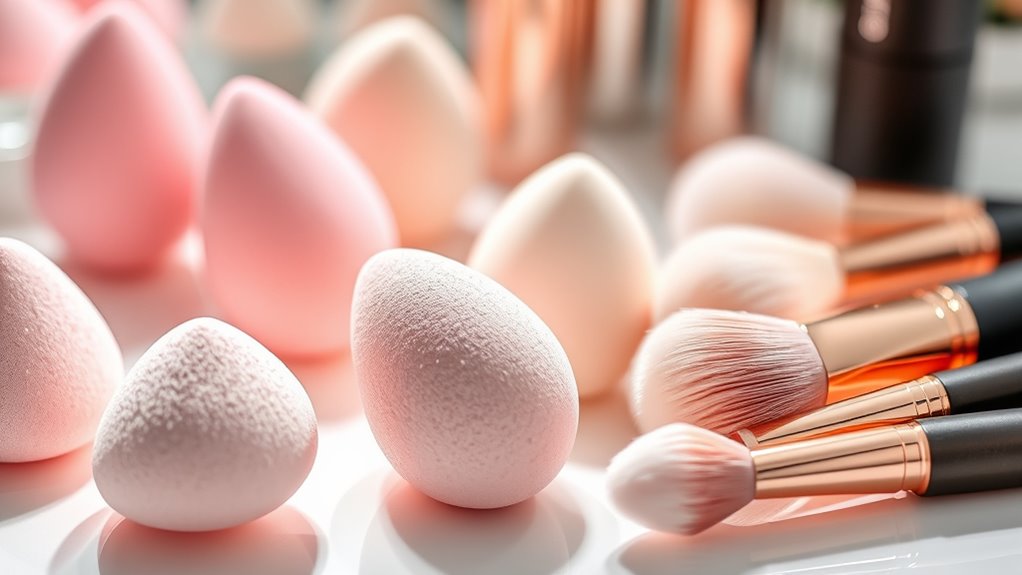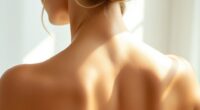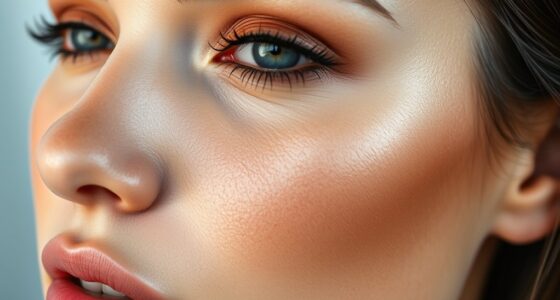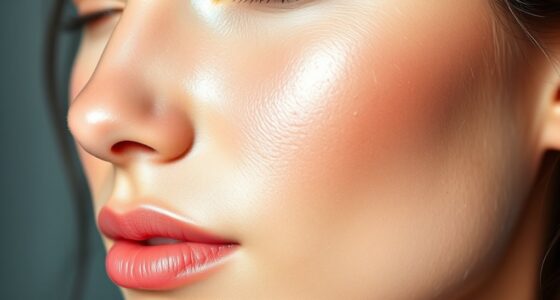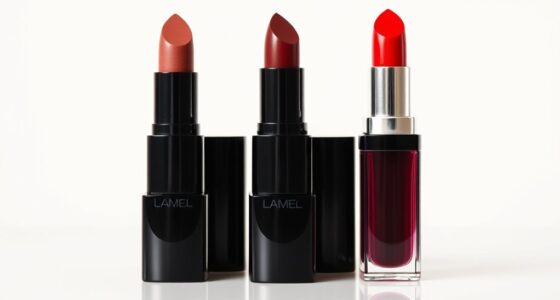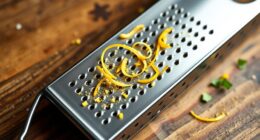Choosing between luxury makeup sponges and brushes depends on your skin type, foundation preference, and desired finish. Sponges offer a seamless, dewy look and quick application, while brushes give you more control for detailed or full coverage looks. Sponges tend to absorb more product and need frequent cleaning, whereas brushes can last longer with proper care. To discover which tool best fits your routine and how to make the most of each, keep exploring.
Key Takeaways
- Sponges provide a seamless, dewy finish ideal for liquid and cream foundations, while brushes offer precise control for full coverage and contouring.
- Damp sponges diffuse product evenly and soften dry patches, whereas brushes allow for targeted application and building coverage gradually.
- Sponges tend to absorb more product and require frequent replacement, making brushes more cost-effective in the long run.
- Proper cleaning extends the lifespan of brushes (1-3 years) and maintains hygiene, while sponges need regular replacement every 3-6 months.
- Your choice depends on skin type, foundation formula, and desired finish—sponges for natural, dewy looks; brushes for detailed, matte effects.
Understanding the Role of Sponges and Brushes in Makeup Application
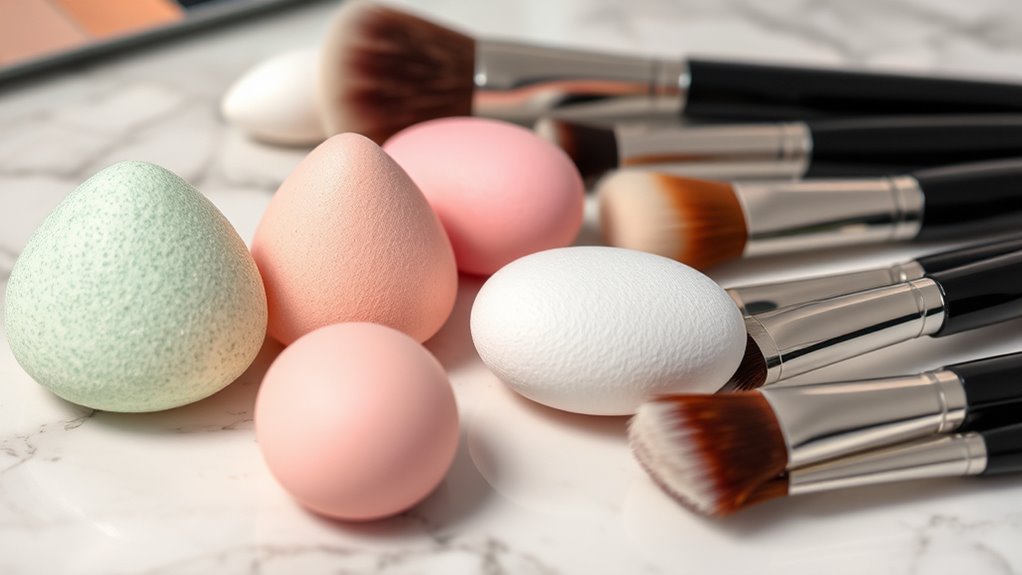
Understanding the role of sponges and brushes in makeup application helps you choose the right tools for your desired look. Makeup sponges are versatile, creating a seamless, airbrushed finish when dampened to diffuse foundation naturally. They excel at reaching tricky areas like under the eyes and around the nose, helping you blend evenly. Brushes, on the other hand, offer greater control and precision, making them perfect for building coverage and sculpting facial features. While sponges tend to absorb more product, leading to potential wastage, brushes use less product and provide more controlled application. Both tools require proper cleaning to prevent bacteria buildup. Knowing how each tool affects application, coverage, control, and blend allows you to select the ideal option for your makeup routine. Additionally, understanding your skin type and the material of your tools can influence their effectiveness and longevity.
Weighing the Benefits and Drawbacks of Each Tool
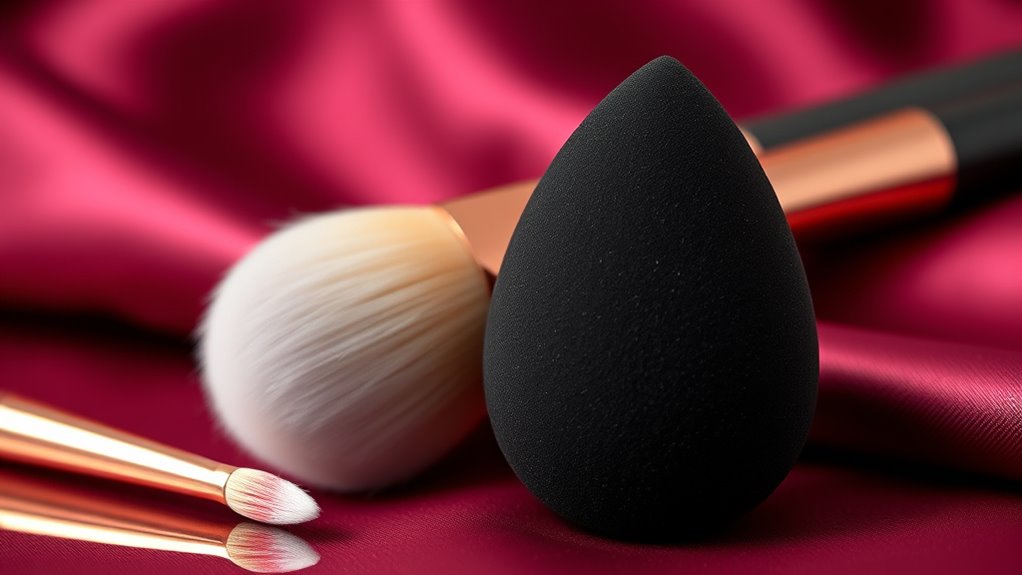
When choosing between sponges and brushes, you’ll want to consider how each tool affects application precision, product waste, and maintenance. Sponges offer quick, easy blending but tend to absorb more product, increasing costs and waste, while brushes provide better control and durability with proper care. Understanding these trade-offs helps you pick the right tool for your makeup routine and budget. Additionally, for those interested in optimizing vehicle performance, Kia Tuning options such as ECU remapping and suspension upgrades demonstrate how tailored modifications can enhance functionality and aesthetic appeal.
Application Precision and Control
Makeup brushes deliver exceptional precision and control, allowing you to target specific areas with detailed application, especially in small or hard-to-reach spots. They enable you to sculpt, contour, and add fine details with finesse, giving you mastery over your technique. Conversely, sponges offer a more seamless, diffused finish with less effort, making them ideal for broad coverage and a natural look. They’re forgiving and easier for beginners to handle, but they lack the pinpoint accuracy of brushes. When it comes to application precision and control:
- Brushes excel at detailed work in tight spaces
- Sponges provide smooth, even coverage quickly
- Brushes require steady hand movements to avoid streaks
- Sponges are more forgiving for a beginner’s technique
- Both tools influence your overall control and finish style
- The choice between them can also depend on the material quality and how well they are maintained. Additionally, brush shape and density play crucial roles in achieving different effects and precision levels. Proper cleaning and care of your tools also impact their performance and the overall application control. Regularly inspecting your tools can help ensure they are in optimal condition, which is essential for consistent application. Understanding the impact of tool quality can help you select the best option for your desired look.
Product Waste and Cost
Although both makeup sponges and brushes have their costs, sponges—especially high-end ones like the Beauty Blender—tend to be more expensive over time because they absorb a significant amount of product, leading to wastage. This increases ongoing costs and reduces cost efficiency. This is why cost efficiency is an important factor to consider when choosing your tools. Brushes, however, use less product per application due to better application control, making them more economical long-term. Frequent washing of sponges can cause material breakdown, shortening their longevity and increasing replacement expenses. Conversely, brushes are easier to sanitize and last longer with proper care. Here’s a quick comparison:
| Aspect | Makeup Sponges | Brushes |
|---|---|---|
| Product Waste | High due to absorption | Low due to controlled application |
| Cost Efficiency | Lower over time | Higher over time |
| Hygiene & Longevity | Material breakdown reduces lifespan | Longer lifespan, easier to clean |
Maintenance and Hygiene
Maintenance and hygiene play a key role in ensuring your tools stay safe and effective. Proper cleaning prevents bacteria buildup, which can cause breakouts or infections. Makeup sponges, especially porous ones, are tricky to clean thoroughly and may hide germs even after washing. Foundation brushes are easier to sanitize thanks to their bristle structure, making maintenance simpler. Some high-end sponges feature antimicrobial materials to boost hygiene, but regular cleaning remains essential. Silicone blenders resist bacteria but require frequent wiping to stay sanitary. Proper storage—like air drying in a well-ventilated space—helps prevent mold, odors, and bacteria. Additionally, understanding best cleaning practices for each tool can significantly improve their longevity and performance. Regular sanitation routines, aligned with hygiene standards, can prevent bacterial contamination and extend the life of your tools. Incorporating proper storage techniques also contributes to maintaining hygiene and extending your tools’ usability. Moreover, being aware of material properties can help you choose the most suitable cleaning methods for each tool type. Staying informed about latest hygiene innovations can further enhance your maintenance routines. Remember, consistent sanitation routines and good maintenance practices are vital for both tools’ longevity, safety, and performance.
Suitability for Different Skin Types and Makeup Formulations
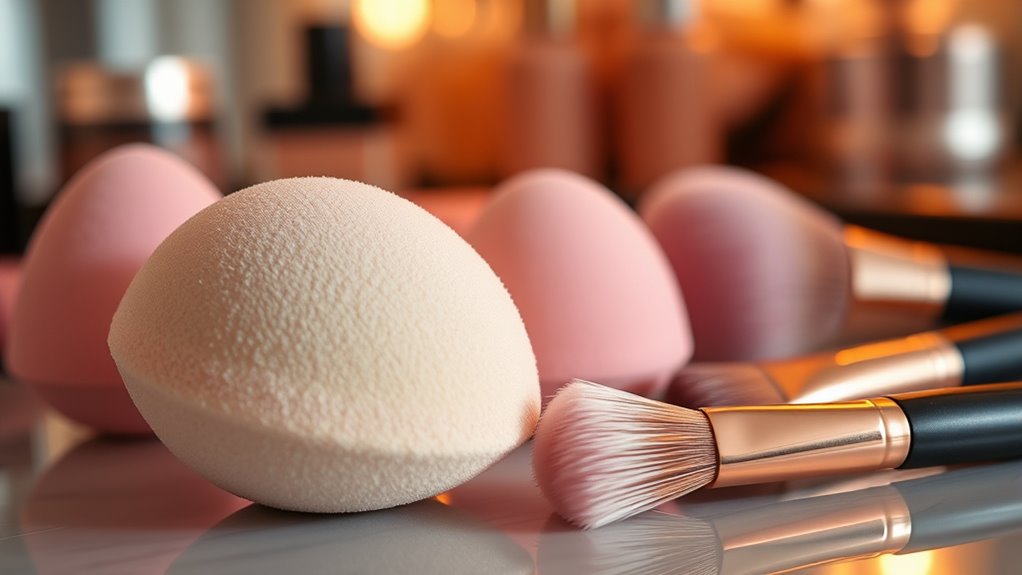
If you have dry skin, damp sponges can help you achieve a luminous finish, while brushes offer more control without adding moisture. For oily or combination skin, brushes are often better for precise application and shine control. Your choice also depends on your foundation type, with sponges ideal for cream and liquid formulas and brushes suited for powders and contouring. Additionally, skin type can influence how your makeup interacts with tools, affecting the overall look and comfort. Considering the tool material, such as synthetic or natural fibers, can also impact application results and skin sensitivity, especially since different materials have varying levels of efficiency, absorption, and compatibility with skincare products. Being aware of angle and density can help you select the most suitable tool for your specific makeup needs.
Dry Skin Compatibility
When it comes to dry skin, choosing between luxury makeup sponges and brushes depends on how you want your finish to look and feel. A damp beauty blender can hydrate dry skin and deliver a dewy glow, blending foundation seamlessly for a natural look. Brushes designed for dry skin offer better brush control, reducing product absorption and helping you build full coverage without emphasizing flakes. Sponges can soften dry patches by diffusing product gently, but their high absorption might require extra product to achieve the desired coverage. Non-porous brushes prevent additional moisture loss, making them ideal for dry skin, while damp sponges add hydration. Additionally, choosing tools with appropriate material properties can enhance application and skin comfort. Your choice hinges on whether you prefer a luminous finish or controlled, matte coverage.
Oily/Combination Suitability
For oily and combination skin, brushes often provide better control over foundation application and help achieve a matte, shine-free finish. They absorb less product, making application more efficient and reducing excess oil buildup. Brushes excel at targeting areas prone to oiliness, like the T-zone, and prevent excess shine throughout the day. Sponges, especially when dampened, can create a dewy look that may not suit oily skin but can help balance moisture in combination skin. However, if not cleaned properly, sponges can trap oil and bacteria, risking breakouts. Proper hygiene with brushes makes them easier to keep bacteria-free. Overall, brushes offer superior oil-control and better blend, making them ideal for oily and combination skin types.
| Feature | Benefit |
|---|---|
| Oil-control | Reduces shine and excess oil |
| Application | Precise and even application |
| Skin type | Ideal for oily/combination skin |
| Blend | Better control over finish |
| Maintenance | Easier to keep bacteria-free |
Techniques and Best Practices for Optimal Results
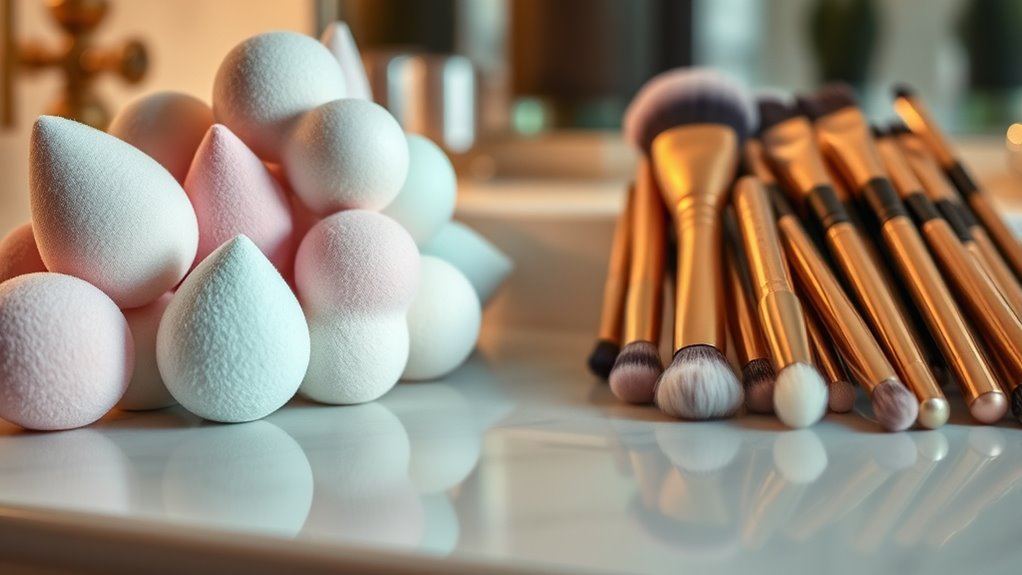
Achieving flawless makeup application depends on selecting the right techniques tailored to your tools and desired finish. Proper techniques maximize coverage, blend seamlessly, and enhance your look. When using a sponge, dampening it helps diffuse foundation for a natural, airbrushed finish, while a brush allows for precise control and buffing for full coverage. Employ stippling motions with brushes to build coverage gradually and reduce streaks, or bounce and pat a sponge for a smoother, minimal-absorption application. For tricky areas like around the nose and under eyes, smaller sponges excel, whereas brushes with tapered edges are perfect for detailed contouring. Keep your tools clean with gentle soap and warm water to maintain *ideal* blending. Experiment with techniques to find what works best for your skin type and finish preference.
Comparing Cost, Maintenance, and Longevity

While luxury makeup sponges like the Beauty Blender typically cost around £14.40 each, high-quality brushes can range from £10 to over £50, influencing your overall investment. Sponges usually need replacing every 3 to 6 months due to wear and bacteria buildup, which can accumulate over time. Maintenance involves daily washing, but they tend to degrade faster than brushes. Brushes, on the other hand, are more durable, lasting 1 to 3 years with proper care. They require regular shampooing to maintain their shape and hygiene. In terms of cost, brushes prove more economical long-term because of their longevity, while sponges may seem cheaper initially but require frequent replacement. Your choice impacts both your budget and the effort needed for maintenance.
Making the Choice: Which Tool Best Fits Your Makeup Routine
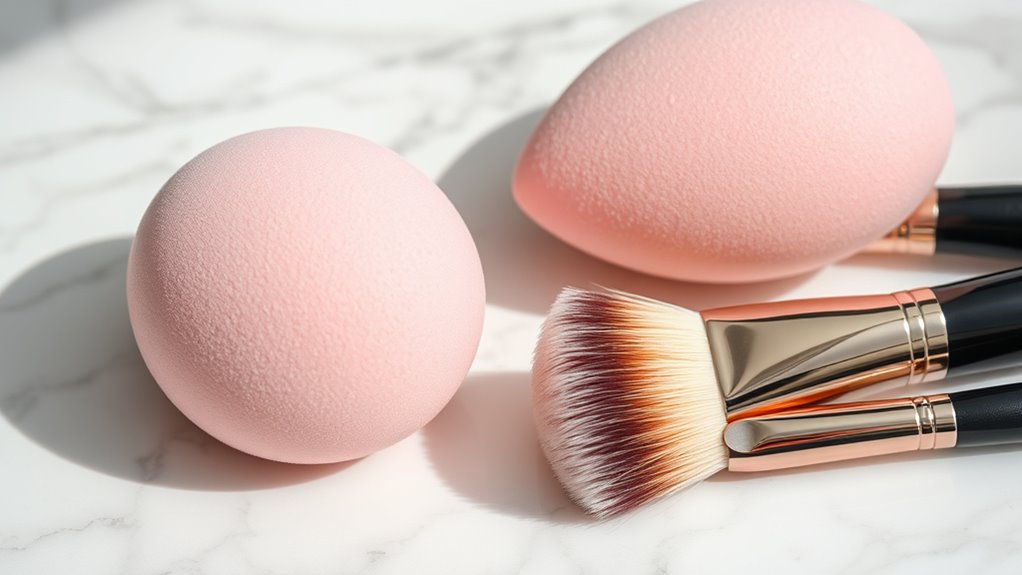
Choosing between luxury makeup sponges and brushes depends on how you prefer to apply your foundation and the look you want to achieve. Your decision hinges on factors like application style, blending needs, and coverage goals. Sponges like the Beauty Blender create a seamless, airbrushed finish with minimal product absorption, perfect for a natural glow. Brushes offer greater control and precision, ideal for full coverage and detailed work. Consider your skin type, whether you prefer a dewy or matte finish, and how much time you want to spend blending. Experimenting with both tools can reveal which suits your personal preference best.
Choosing between sponges and brushes depends on your desired finish and blending style.
- Achieve a natural glow with sponges
- Get full coverage with brushes
- Enhance blending for a flawless look
- Match tools to your skin type
- Find what fits your routine best
Frequently Asked Questions
Which Is Better, Blending Sponge or Brush?
When choosing between a blending sponge or brush, it depends on your preferences and needs. If you want a natural, seamless finish, a damp sponge is great for quick, even blending and a dewy look. If you prefer more control and full coverage, a brush is ideal, especially for detailed work. You might even find that using both tools together gives you the best results, depending on your makeup style.
What’s More Hygienic, a Beauty Blender or a Brush?
Like a knight choosing their armor, you want the most hygienic option. A brush with synthetic bristles, when cleaned properly with antibacterial cleansers, can be more reliable at eliminating germs. Sponges, especially traditional ones, are porous and can trap bacteria if not cleaned thoroughly, often needing replacement. Silicone blenders stand out as the most hygienic, because they’re non-porous and easy to disinfect, keeping your skin safer and cleaner.
What Is the Difference Between Beauty Blender and Real Techniques Sponge?
You want to know the difference between a Beauty Blender and a Real Techniques sponge. The Beauty Blender has an egg shape, is highly porous, and creates a seamless, dewy finish, but absorbs more product and costs more. The Real Techniques sponge features a flatter edge, is denser and bouncier, offers faster, more precise application, and is more affordable. Both work well for liquids, creams, and powders, but they deliver different finishes and ease of use.
What Is the Best Thing to Blend Foundation With?
When blending foundation, you should choose tools based on your desired finish. If you want a natural, dewy look, a damp sponge is your best option because it provides a seamless, airbrushed effect. For more control and full coverage, a foundation brush works better, allowing you to sculpt and build coverage precisely. Your choice depends on your skin type, the finish you want, and personal preference.
Conclusion
Choosing between luxury makeup sponges and brushes depends on your skin, style, and budget. Did you know that 65% of makeup artists prefer brushes for precision, while 35% favor sponges for a flawless finish? Ultimately, your perfect tool enhances your routine and boosts confidence. Experiment with both to see what feels best—after all, the right tool makes all the difference in achieving your ideal look.
